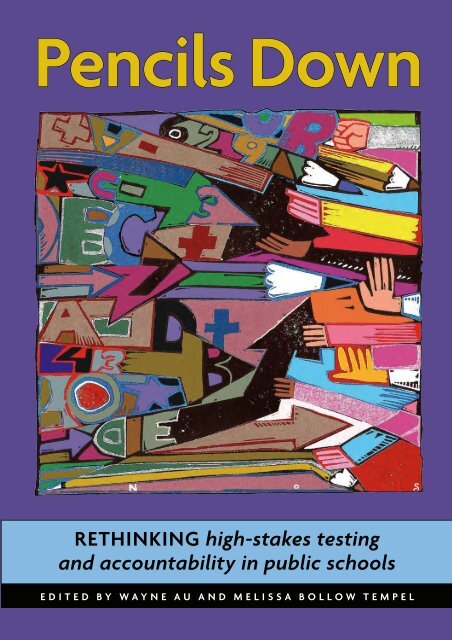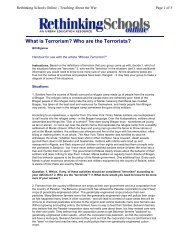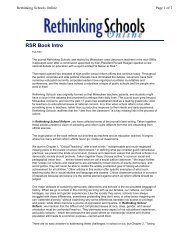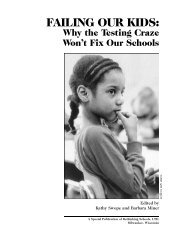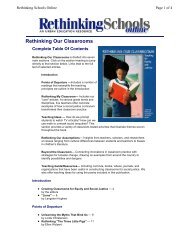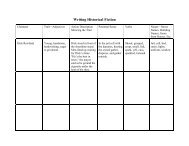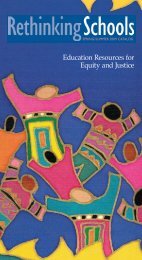Education - Rethinking Schools
Education - Rethinking Schools
Education - Rethinking Schools
- No tags were found...
Create successful ePaper yourself
Turn your PDF publications into a flip-book with our unique Google optimized e-Paper software.
Pencils DownRETHINKING high-stakes testingand accountability in public schoolsEDITED BY WAYNE AU AND MELISSA BOLLOW TEMPEL
Pencils DownRETHINKING high-stakes testingand accountability in public schoolsEDITED BY WAYNE AU AND MELISSA BOLLOW TEMPELRANDALL ENOS. A RETHINKING SCHOOLS PUBLICATION .
Pencils Down: <strong>Rethinking</strong> high-stakes testing and accountability in public schoolsEdited by Wayne Au and Melissa Bollow TempelA <strong>Rethinking</strong> <strong>Schools</strong> Publication<strong>Rethinking</strong> <strong>Schools</strong> Ltd. is a nonprofit educational publisher of books, booklets,and a quarterly magazine on school reform, with a focus on issues of equity and social justice. Torequest additional copies of this book and/or a catalog of other publications, or to subscribe to<strong>Rethinking</strong> <strong>Schools</strong> magazine, contact:<strong>Rethinking</strong> <strong>Schools</strong>1001 East Keefe AvenueMilwaukee, WI 53212800-669-4192www.rethinkingschools.org© 2012 <strong>Rethinking</strong> <strong>Schools</strong> Ltd.First editionProduction Editor: Catherine CapellaroCover and book design: The FlynstituteCover and chapter head illustrations: Randall EnosProofreading: Amalia OulahanIndexing: Marilyn FlaigBusiness Manager: Mike TrokanAll rights reserved. Except as permitted below, no part of this book may be reproduced in any form or byany means, including electronic, without the express prior written permission of the publisher, except forbrief quotation in an acknowledged review. Individuals may photocopy excerpts from this book for usein educational settings (physical settings only; internet use is not permitted), as long as such material isfurnished free to students or workshop participants. For sale of any portion of this book as part of coursepackets, contact the Copyright Clearance Center for permissions and appropriate assesment of fees.If you have any questions, contact <strong>Rethinking</strong> <strong>Schools</strong> at the above address.Library of Congress Cataloging-in-Publication DataPencils down : rethinking high-stakes testing and accountability in public schools / edited by Wayne Au andMelissa Bollow Tempel.—First edition.pages cm.— (A <strong>Rethinking</strong> <strong>Schools</strong> publication)A collection of articles from <strong>Rethinking</strong> <strong>Schools</strong> magazine.Includes bibliographical references and index.ISBN 978-0-942961-51-5 (alk. paper)1. <strong>Education</strong>al tests and measurements—United States. I. Au, Wayne, 1972- II. Tempel, Melissa Bollow,1978- III. <strong>Rethinking</strong> schools.LB3051.P46 2012371.26 —dc232012010474
We dedicate this book to Maya Lu and Masamifor bravely being the first in their school to opt outof computerized testing;and Makoto, Haden, Nehuen, and Olliein hopes that the testing will never reach them..
iv . Pencils Down: <strong>Rethinking</strong> high-stakes testing and accountability in public schoolsAcknowledgementsWe thank <strong>Rethinking</strong> <strong>Schools</strong> editors Linda Christensen, Kelley DawsonSalas, Stan Karp, David Levine, Larry Miller, Bob Peterson, StephanieWalters, Terry Burant, Helen Gym, Rita Tenorio, Dyan Watson, Kathy Williams,Kathy Xiong, Bill Bigelow, and Jody Sokolower for their ongoing workand support in shaping this book; Catherine Capellaro for helping shepherdthis book through the process; Patrick J.B. Flynn for his artistic direction andpatience; Randall Enos for his creative expression; Amalia Oulahan for her attentionto detail; Kris Collett, Tegan Dowling, and Mike Trokan for doing somany things that make <strong>Rethinking</strong> <strong>Schools</strong> run; and, of course, the contributorsto Pencils Down for everything they are doing to challenge high-stakes testing.We’d also like to thank our partners, Mira and Gene, for understanding theimportance of getting this book published.—Wayne Au and Melissa Bollow Tempel
. vT A B L E O F C O N T E N T SAcknowledgements. . . . . . . . . . . . . . . . . . . . . . . . . . . . . ivIntroduction. . . . . . . . . . . . . . . . . . . . . . . . . . . . . . . . . . 1It’s time to put the pencils downWAYNE AU AND MELISSA BOLLOW TEMPELPart 1:Testing, Testing, 1, 2, 3. . .Failing Our Kids. . . . . . . . . . . . . . . . . . . . . . . . . . . . . . . . 9Why the testing craze won’t fix our schoolsKATHY WILLIAMS AND BARBARA MINERCommon Questions about Standardized Tests. . . . . . . . . . . . . 12KATHY WILLIAMSStandards: Decoy or Quality Control?. . . . . . . . . . . . . . . . . . 16ASA HILLIARDA Child Is Not a Test Score . . . . . . . . . . . . . . . . . . . . . . . . 21Assessment is a civil rights issueMONTY NEILLThe Straitjacket of Standardized Tests . . . . . . . . . . . . . . . . . 31Where is the standardized test that can measure passionfor learning, respect for others, and human empathy?TOM McKENNARacism in the History of Testing: Legacies for Today . . . . . . . . . 34ALAN STOSKOPFPart 2:Testing KidsTesting Kindergarten. . . . . . . . . . . . . . . . . . . . . . . . . . . . 43Young children produce lots of dataKELLY McMAHONTesting Lang . . . . . . . . . . . . . . . . . . . . . . . . . . . . . . . . . 46AMY GUTOWSKI
vi . Pencils Down: <strong>Rethinking</strong> high-stakes testing and accountability in public schoolsAll Work and No Play . . . . . . . . . . . . . . . . . . . . . . . . . . . 47How educational reforms are hurting our preschoolersSHARNA OLFMANA Dark Cloud on the U.S. Horizon . . . . . . . . . . . . . . . . . . . . 51A teacher’s experience in England is a cautionary taleMELISSA SCHIEBLETesting Our Sanity . . . . . . . . . . . . . . . . . . . . . . . . . . . . . 55A 4th-grade bilingual teacher shares her storyof preparing students for mandated testsKELLY DAWSON SALASEdwina Left Behind. . . . . . . . . . . . . . . . . . . . . . . . . . . . 59SÖREN WUERTHThe Scripted Prescription . . . . . . . . . . . . . . . . . . . . . . . . . 62A cure for childhoodPETER CAMPBELLTesting Our Limits . . . . . . . . . . . . . . . . . . . . . . . . . . . . .66MELISSA BOLLOW TEMPELPart 3:Testing TeachingTeaching in Dystopia . . . . . . . . . . . . . . . . . . . . . . . . . . . . 73Testing has a stranglehold on educationWAYNE AUFighting for Electives. . . . . . . . . . . . . . . . . . . . . . . . . . . . 78Lessons in courageMELISSA BOLLOW TEMPELStandards and Testing Attack Multiculturalism . . . . . . . . . . . . 83BILL BIGELOWThink Less Benchmarks. . . . . . . . . . . . . . . . . . . . . . . . . . 90A flawed test does more harm than goodAMY GUTOWSKI
. viiAbout Those Tests I Gave You . . . . . . . . . . . . . . . . . . . . . . 94An open letter to my studentsRUTH ANN DANDREAA Teacher Pushed to the Edge. . . . . . . . . . . . . . . . . . . . . . . 96SARAH KNOPPPlaying Smart . . . . . . . . . . . . . . . . . . . . . . . . . . . . . . . 101Curricular activism and resisting the script of high-stakes testingWAYNE AUSupport That Can’t Support . . . . . . . . . . . . . . . . . . . . . . 106One teacher’s induction program experienceELAINE ENGEL KESWICKComing Soon to Your Favorite Credential Program: .National Exit Exams . . . . . . . . . . . . . . . . . . . . . . . . . . . .110ANN BERLAKResponses to “Coming Soon to .Your Favorite Credential Program”. . . . . . . . . . . . . . . . . . . . 117Part 4:Testing the TestsNeither Fair nor Accurate . . . . . . . . . . . . . . . . . . . . . . . . 127Research-based reasons why high-stakes testsshould not be used to evaluate teachersWAYNE AUA Test Scorer’s Lament. . . . . . . . . . . . . . . . . . . . . . . . . . 132Scenes from the mad, mad, mad world of testing companiesTODD FARLEYThe Loneliness of the Long-Distance Test Scorer . . . . . . . . . . 135DAN DiMAGGIOFuzzy Math. . . . . . . . . . . . . . . . . . . . . . . . . . . . . . . . . 145MEREDITH JACKS
viii . Pencils Down: <strong>Rethinking</strong> high-stakes testing and accountability in public schoolsApologies to Sandra Cisneros. . . . . . . . . . . . . . . . . . . . . . 148How ETS’ computer-based writing assessment misses the markMAJA WILSONOn White Preference. . . . . . . . . . . . . . . . . . . . . . . . . . . 156JAY ROSNERTesting What Matters Least. . . . . . . . . . . . . . . . . . . . . . . 158What we learned when we took the Praxis Reading Specialist TestMAIKA YEIGH, ANDIE CUNNINGHAM, AND RUTH SHAGOURYPart 5:Resisting and Responding .to High-Stakes TestingResponding to Test-Driven Reform. . . . . . . . . . . . . . . . . . . 167BARBARA MINERHigh-Stakes Harm. . . . . . . . . . . . . . . . . . . . . . . . . . . . . 169Teaching students to read testsLINDA CHRISTENSENAn Untold Story of Resistance . . . . . . . . . . . . . . . . . . . . . 175African American educators and IQ testing in the 1920s and 1930sALAN STOSKOPFTeaching Is Not Testing . . . . . . . . . . . . . . . . . . . . . . . . . 183A community-led struggle to find an alternativeto California’s graduation examTINY (AKA LISA) GRAY-GARCIANone of the Above . . . . . . . . . . . . . . . . . . . . . . . . . . . . 189Defiant teachers show they have had enough of high-stakes testingAMALIA OULAHANTaking a Stand for Learning . . . . . . . . . . . . . . . . . . . . . . . 194Chicago teachers speak out against a “really bad test”GREG MICHIE
. ixTesting, Tracking, and Toeing the Line. . . . . . . . . . . . . . . . . 197A role play on the origins of the modern high schoolBILL BIGELOWOpting Out and Speaking Up. . . . . . . . . . . . . . . . . . . . . . 210A national movement grows to opt out of state testsPEGGY ROBERTSONTemplate for Opting Students Out of State Tests. . . . . . . . . . 213Part 6:Beyond High-Stakes .Standardized TestingHallmarks of Good Assessment. . . . . . . . . . . . . . . . . . . . . 217THE EDITORS OF RETHINKING SCHOOLSAlternatives to Standardized Tests. . . . . . . . . . . . . . . . . . . 218BOB PETERSON AND MONTY NEILLA Better System for Evaluating <strong>Schools</strong> and Students. . . . . . . . 229FAIRTEST: NATIONAL CENTER FOR FAIR & OPEN TESTINGMultiple Measures . . . . . . . . . . . . . . . . . . . . . . . . . . . . 231It’s not easy to escape the high-stakes trap,but here are some examples of alternativesMONTY NEILLTheir Report Card–and Ours . . . . . . . . . . . . . . . . . . . . . . 235How do we know if schools are doing a good job?And how can we make them better?PORTLAND AREA RETHINKING SCHOOLSBasketball and Portfolios . . . . . . . . . . . . . . . . . . . . . . . . 241LINDA CHRISTENSENAnother Path Is Possible. . . . . . . . . . . . . . . . . . . . . . . . . 248Despite the pressures of high-stakes testing, two Chicagoprincipals keep an eye on what mattersGREG MICHIE
x . Pencils Down: <strong>Rethinking</strong> high-stakes testing and accountability in public schoolsSteady Work. . . . . . . . . . . . . . . . . . . . . . . . . . . . . . . . 255Finland builds a strong teaching and learning systemLINDA DARLING-HAMMONDTeaching in Dangerous Times . . . . . . . . . . . . . . . . . . . . . . 263In this era of demands for teacher quality, it is crucialto develop culturally relevant ways to assess teachersGLORIA LADSON-BILLINGSTeachers Teaching Teachers. . . . . . . . . . . . . . . . . . . . . . . 271In Portland, teachers work together to createteacher-centered professional developmentLINDA CHRISTENSENTaking Teacher Quality Seriously. . . . . . . . . . . . . . . . . . . . 278A collaborative approach to teacher evaluationSTAN KARPAuthor Bios . . . . . . . . . . . . . . . . . . . . . . . . . . . . . . . . 285Index . . . . . . . . . . . . . . . . . . . . . . . . . . . . . . . . . . . 289
High-Stakes HarmTeaching students to read testsLINDA CHRISTENSENPart 5 • Resisting and Responding to High-Stakes Testing . 169Tests today are high stakes. Based on these numbers, students are retained,placed in summer school and remedial classes; schools are reconstituted, andteachers’ and principals’ salaries rise and fall. Students, especially those who “fail”the tests, internalize the failure, and question their ability and their intelligence.They learn to blame themselves, and some come to believe they will not succeedbecause they are not capable enough. As my daughter said after receiving a 3 (notcompetent) on an oral Spanish test, “Maybe I don’t have what it takes.” The testtook away the experience of animated conversations with her host family in Cuernavacaas well as her ability to navigate Mexico City. Instead of questioning thevalidity of the measurement tool as an “authentic assessment,” especially comparedto her experience in Mexico, she questioned herself.So while critical teachers might stand back and say we don’t want to have anythingto do with tests, you better believe that we can’t just go on with business asusual. The question for anyone who cares about kids is how do we retain our criticalstance on assessments while preparing students for them? Can we “teach the tests”without compromising what we know to be true about teaching and learning?My friends at low-achieving elementary schools have been counseled to acclimatestudents to tests by redesigning their regular curriculum so that studentscan get accustomed to multiple-choice questions. But in an activist classroom,that’s not easy. How can a role play about an important historical or social issuebe reformatted into a multiple-choice activity? How does an a, b, c, d answer formatencourage students to imagine themselves an interned Japanese American ora Cherokee Indian facing government-ordered removal? Teachers are also askedto mimic the more “authentic” assessments in fairly inauthentic ways. A kindergartencolleague was asked by the 3rd-grade teachers to prepare students for thestate six-trait analysis scoring guide by giving them 1-6 scores on everything fromlining up at the door to tying their shoes and counting.Clearly, this isn’t the kind of teaching we want to happen in our classrooms.To achieve real gains in student knowledge and skill, we must continue to givestudents a rich curriculum with varied opportunities to use their learning in realworld activities. This material will generate growth that may or may not be reflectedin test scores, but will increase the likelihood of students seeing themselvesas readers, writers, historians, scientists, mathematicians, and thinkers.However, I live in a state that has filled our classrooms with tests—multiplechoice and work samples. As a teacher and mother who has patched up the woundstest scores left behind and as the victim of a school that was reconstituted in partdue to low test scores, I am a firm advocate in fighting against the over-assessment
170 . Pencils Down: <strong>Rethinking</strong> high-stakes testing and accountability in public schoolsThe question for anyone who caresabout kids is how do we retain ourcritical stance on assessments whileof students. But I also believe we mustseize the opening to help our studentscritically analyze these exams and themotives that put them into practice,as well as teach them how to improvepreparing students for them?their skills and scores. Thus, we needto teach students to critique the testsas well as coach them on how to increase their performance.Talk Back: Questioning the Assumptions of the TestA social justice curriculum equips students to question what is often taken forgranted. Tests have become as much a part of the curriculum as books. (In fact,these days there seems to be more money for testing, test preparation, and testscoring than for the books we need to teach. A good question might be: “Why arewe spending so much money on testing when we need books?”) In critical classrooms,we can make testing the object of our curiosity.Begin by questioning the origins and purpose of these tests. I ask students:Who made them? What are the tests supposed to measure? What informationwill be generated from the scores? Who will have access to that information andhow will it be used? For example, in Oregon, students take multiple tests. Onemight think that these tests will be used to help teachers more accurately assesstheir students’ abilities or progress to improve instruction. But because the testsare given during the school year—from February to April—and the scores aren’treturned to the schools until after the school year has ended, one has to questionthe legitimacy of that claim.If we really want to know how well students are doing in school, why can’t weask teachers, students, or parents? Why don’t we look at student work? Portfolios?Dave Hamilton, an award-winning science teacher, wrote the following in theOregonian:[T]ests given by classroom teachers are almost never high stakes. Teachers typicallyuse an average of test scores (never a single test score) as only one indicatorof student achievement. They also rely on written work such as papers and otherassignments, class participation, and special projects. Compared to the state’ssingle test score, teachers have a wealth of information on which to assess studentachievement . . . [T]eachers are the only people with the intimate knowledge ofstudent achievement over time needed to make such judgments.Another way to scrutinize the tests is to find statistics generated from theseexams. In my school district, the local newspaper happily prints scores and ratesschools, but our research and evaluation department also has broken the scoresdown by gender and race. Have students examine the statistics. Which school inthe district usually receives high scores? Which ones don’t? Is there a pattern? Arethe scores related to parents’ income? Race?This one is tricky because I don’t want to leave the students with the idea that
Part 5 • Resisting and Responding to High-Stakes Testing . 171The SAT/ACT scores becomea brand of shame studentscarry long after they bubblein the last answer.race and income are indicators of intelligenceor the only factors determiningacademic achievement. It is importantto examine the questions to see howthe content might favor one race or onegender or one income bracket. FairTestExaminer is a good resource for this informationon the SATs. They reported how students of color scored higher, forexample, on passages that feature multicultural readings. [See also Jay Rosner’sarticle, “On White Preference,” in this book.]Sometimes you can find these selections in your own city or state assessments.Ruthann Hartley, a former colleague from Jefferson High School, was furious aftershe administered the state reading test. According to Hartley, a disproportionatenumber of questions examined a passage and chart from Consumer Reports onfrequent flyer benefits. Hartley noted, “This is a problematic item for teenagers,but especially for low-income students who don’t travel. Passages like this raisethe question of what is being tested. If students answer incorrectly, is it becausethey can’t read or because they don’t have the background knowledge?”Students might also question how the test results are used. Who benefits ifthey get high scores? Are students placed in honors or remedial classes? Givenscholarships? Special programs? Are teachers’ or principals’ salaries tied to theresults? Have students interview school and district administrators and departmentchairs about how students are placed in honors classes or gifted and talentedprograms. Are test scores the only criterion?Asking students to become investigators prior to exam time can help put thetests in a social context, but more than that, it diminishes the size of their opponent.Students see behind the Wizard of Oz curtain and realize that no geniusesare laboring to construct these tests. The test-item creators are not people whohave scrutinized the great order of the universe and then created these 20, 40, or60 reading and math problems to determine which students will succeed in lifeand which ones will fail. [See also Dan DiMaggio’s chapter, “The Loneliness ofthe Long Distance Test Scorer,” included in this book.]Investigating the Origins of the SATWhile my junior and senior students weren’t saddled with the Certificate of InitialMastery (CIM) reading, writing, and math tests—which Oregon 3rd, 5th, 8th, and10th graders currently take—they were having their behinds kicked by the SATs.After their encounters with these grueling tests, they fumed at me and their mathteachers. “Those tests might as well have been written in Greek!” Shameka saidafter the exams ruined her Saturday. For my students, an investigation of the historyof the SATs was as critical as teaching them how to improve their scores. TheSAT/ACT scores become a brand of shame students carry long after they bubblein the last answer. If they score low on the test, they doubt themselves and wonderif they are as capable as the kid who scored higher.
172 . Pencils Down: <strong>Rethinking</strong> high-stakes testing and accountability in public schoolsTo help students understand the origins of the exam and help them put thescore in perspective, my class reads a chapter from David Owen’s book None of theAbove called “The Cult of Mental Measurement.” In this essay, Owens describesthe racist past of the SATs and also points out how race continues to be a factor inthese kinds of standardized tests today. Students are outraged by their discoveries.(For example, the founder of the SATs, Carl Campbell Brigham, published inthe same eugenics journal that Adolf Hitler wrote for.) But even without this gemof a chapter to use, getting students to investigate the origin and use of tests intheir school district or state is a good place to start. (See Bill Bigelow’s “Testing,Tracking, and Toeing the Line: A Role Play on the Origins of the Modern HighSchool” in this volume to help students develop a critique of the historical motivationbehind the testing industry.)Examining the TestsOnce students have gained a critical edge on the tests, we can help them improvetheir performance by examining both the content and the format of thetests themselves. The more they know about how the questions are put togetheras well as the vocabulary of the material, the better prepared they are to meetthe challenge.In my senior English class, students demystified the SATs and used theirknowledge to teach others about their discoveries. We started by analyzingeach of the verbal sections of the SATs. We examined the instructions, language,and “objectives” of each section. We took apart the analogies and figuredout the kinds of relationships they paired. (We used The Princeton Review:Cracking the SAT to help us wade through and prepare. David Owens wrote theforeword.) We looked at how the language and culture of the SATs reflectedthe world of upper-class society with words like heirloom, inheritance, conservatory,and regatta.After examining each section and taking the tests a few times, I asked studentsto construct their own tests using the culture, content, and vocabulary ofour school—from sports to dance to awards. Pairs of students worked togetherdeveloping questions that the entire class examined; then we put together theJefferson Achievement Tests ( JAT).JATEach question below consists of a related pair of words or phrases, followed by four letteredpairs of words or phrases. Select the lettered pair that best expresses a relationship similar tothat expressed in the original pair.1. Tony: Play ::a) Broadway : Annieb) Oscar : Tom Hanksc) Brandon : soccerd) Howard Cherry : sports
Part 5 • Resisting and Responding to High-Stakes Testing . 173(The correct answer is d. The “Tony” is anaward given for a play. At Jefferson,the “Howard Cherry” is an award given forsports.)2. New Growth : perm ::a) press : straightb) weave : longc) corn row : braidd) nails : fillAfter examining each sectionand taking the tests a few times,I asked students to construct theirown tests using the culture, content,and vocabulary of our school.(The correct answer is d. When you get “new growth,” it is time for a perm. In the sameway, if you wear acrylic nails and your nails grow out, you need to get a fill.)4. Red Beans and Rice : play ::a) corn and tortillas : runb) song : dancec) mozzarella : cheesed) sonata : musical(The correct answer is c. Red Beans and Rice is the name of a play; mozzarella is the nameof a kind of cheese.)5. Dancebelt : boxers ::a) shoes : socksb) student : teacherc) leotard : leg warmersd) prison : freedom(Although this one changes form from concrete nouns to abstract nouns, I like the humorand use of Jefferson’s dance legacy in the answer—d. As a male dancer explained, a dancebeltsecures a male dancer’s privates during dance. Comparing the dancebelt to boxers islike comparing prison to freedom.)After completing the test, students took the JAT up to Ruth Shagoury’seducation classes at Lewis & Clark College. My students asked the pre-serviceteachers to imagine that the JAT was a high-stakes test that will determinetheir future—what college they get into, scholarships, etc. After the tests, studentsdiscussed the issues of testing and language. In this way, my students hada real audience whose future teaching practice was hopefully enlightened bytheir work.Obviously, our JAT is not an exact equivalent of the SAT, but developing theirown analogies from Jefferson’s culture helped students understand the mechanicsof the exam. It also made them see that if they were the test makers, using theirculture and their vocabulary, they could also devise a test that could be used toexclude some and include others.Perhaps the most important lesson of the unit came when students asked,
174 . Pencils Down: <strong>Rethinking</strong> high-stakes testing and accountability in public schools“Why would someone want to devise a test to keep students out of a college theywant to enter?” Indeed.Teaching students to examine the history and motives of local and state testsand preparing them for the big day(s) is no substitute for fighting to end the encroachmentof assessments in our classrooms. Although the work I’ve proposedmay raise student scores by a few points and help students question the tests’ legitimacyas well as their results, our bigger work as teachers and parents is to engagein the battle to stop testing that makes young people, like my daughter, questiontheir ability..


